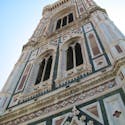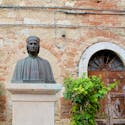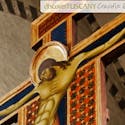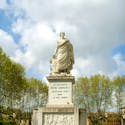Giovanni Fattori is a famous Tuscan painter, who lived in the 19th century between Florence and Livorno. He is certainly the leading figure of the Macchiaioli, a term used to describe the Tuscan painters that were forerunners of the Impressionists and their use of natural light and colors.
Painter and engraver, Fattori played an important role in Italian painting. He is famous for his Tuscan landscapes, especially depicting Maremma, for his portraits and historical subjects.
His Life
Giovanni Fattori was born in Livorno on September 6, 1825. He was a talented child and at the age of 15 he started studying art and drawing. In 1846 he moved to Florence to study at the Academy of Fine Arts.
In 1848 he got involved in the Risorgimento fights as a delivery boy of the clandestine press in favor of Italian unification. The following year, he witnessed Livorno's invasion and he was shocked. The event influenced his later works. The military and historical subjects became important for his work.
In 1850 he started hanging around Caffè Michelangelo in Florence on via Larga (today via Cavour), that was the meeting point for anti-academic artists discussing new forms of expression for art. Here he met Telemaco Signorini, a young talented Florentine painter with whom he founded the Macchaioli a few years later.
The "macchia", area of light and shadow in painting, became fundamental in his work and he painted many portraits, landscapes and historical subjects such as After the Battle of Magenta (Il Campo Italiano dopo la Battaglia di Magenta) considered the first Italian painting of contemporary history.
At the beginning of the 1860s he moved to Livorno often visiting Castiglioncello and his friend and art critic Diego Martelli. In 1869, he was appointed professor at Florence's Academy of Fine Arts and later he became honorary professor.
After 1880 he often visited Maremma, an area he finds extremely fascinating and which he paints in many of his latest works. These are the most productive years for Fattori.
Giovanni Fattori died in Florence on August 30, 1908.
His works
Giovanni Fattori was a very productive and extremely appreciated artist. He was one of the leaders of the Macchiaioli and of the "macchia" technique which intended to reproduce the impressions given by reality with spots (macchie) of colors, of lights and shadows.
His preferred subjects were portraits of friends and relatives, as well as landscapes especially of the Maremma area, and military and historical subjects related to contemporary events.
Among his most important artworks in Florence are La rotonda Palmieri, Carro con i buoi, Barrocci romani and Lo Staffato at the Gallery of Modern Art of Pitti Palace.
In Livorno, his birthplace, the Civic Museum Giovanni Fattori has the portrait of Mrs Martelli in Castiglioncello, the Torre Rossa and Assalto alla Madonna della Scoperta.
Other relevant works of this great Tuscan artist are the Portrait of Cousin Argia, portrait of Mr Martelli in Castiglioncello and The rest. He also created many beautiful etchings depicting Maremma and the Tuscan landscape.
What turns Fattori's works into masterpieces is the unique technique and use of the macchia and his authentic representation of reality.



